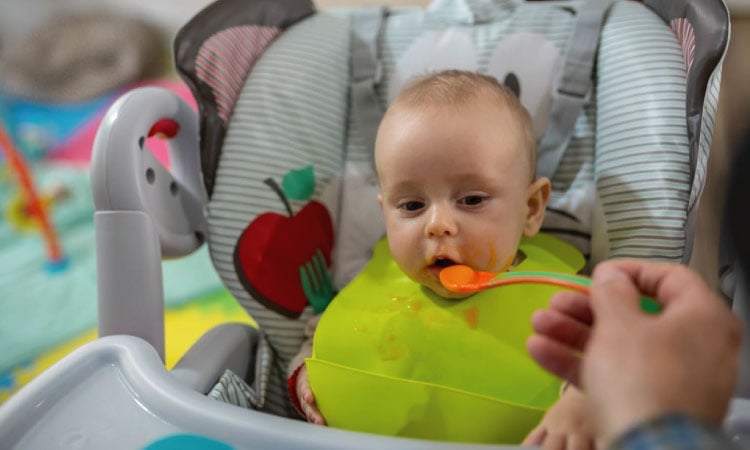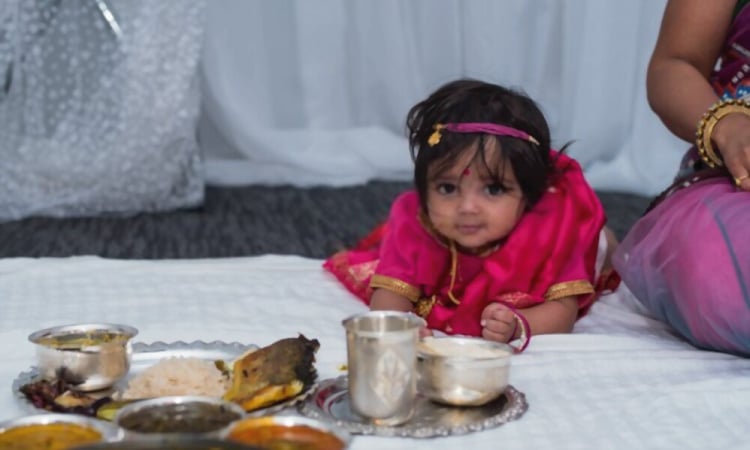In Hindu tradition, the baby’s transition from breastfeeding/formula feed to solid food is performed with a process called Annaprashan – First Rice Eating Ceremony. Like any other first milestone of the baby, the first taste of solid food from that of liquid remains special to every parent. Annaprashan is hence celebrated as an event all over the country.
Annaprashan or Annaprasana in Sanskrit means ‘food eating’ or ‘food feeding’ which marks the beginning of solid food in the baby’s life. It is celebrated with the presence of elders and parents of the little one. Watching the babies reach their milestones is a memorable moment in every parent’s life. Many ceremonies are conducted in different cultures and religions to keep note of these important milestones and so is Annaprashan.
Let us discuss in detail what is Annaprashan and why is the Annaprashan ceremony performed.
What Is Annaprashan?
Annaprashan ceremony marks the beginning of solid food in a baby’s life. It is also known as the first rice-eating ceremony and is called Choroonu in Kerala, Mukhe Bhaat in Bengal, and Bhaatkhulai in the Garhwal hills. Upon performing this ritual, you can slowly start with the baby’s weaning food and include them as a part of your baby’s diet.
Related Reading: Baby Cries After Feeding- 8 Reasons And 6 Ways To Deal With It
Before the first year of the child, there are important rituals that are performed such as welcoming the child to the world (Jatakarma) and naming the child (Namakarana). The other ritual which is of most importance is the Annaprashan. Though the rites and rituals of Annaprashan differ from region to region, the basic concept remains the same – welcome the baby to the world of solid foods.
Why Is The Annaprashan Ceremony Performed?
Annaprashan is the holy ceremony in the Hindu culture to mark the beginning of a baby’s food intake. In simple words, when the baby is ready for other foods apart from the mother’s breast milk, this ritual is performed. Mostly, it is done by offering kheer to the baby. Hence, it is referred to as the ‘First Rice-Eating Ceremony’ in English.
Annaprashan is usually done after the sixth month and before the first year of the child. Annaprashan ceremony must be performed in a holy ambiance with all the step-by-step Annaprashan Vidhi (rituals), as it is one of the most important parts of your baby milestone.
Related Reading: 15 Common Foods That Can Be Unsafe For Babies
Annaprashan– How To Perform The Ceremonny

Food plays an important role as it gives us both nourishment and strength. Annaprashan ceremony respects the significance of food and its first consumption in our lives. The day the baby starts to consume their food is an important aspect of their life. Hence, this ritual needs to be done in a holy ambiance and with divine respect.
Annaprashan ceremony is performed after consulting the priest for a good time and good day. Before doing the ceremony, it is important to set up everything so that you do not miss anything at the last minute. The baby is usually dressed up in traditional wear, mostly a kurta dhoti or a choli lehenga.
The Annaprashan starts with a puja for the wellness of your baby’s health followed by the feeding of the prasad or the first solid food of the baby. Relatives, well-wishers, and friends will be invited to bless the baby. A feast will be arranged to treat the invitees.
Annaprashan Vidhi/Procedure
Annaprashan takes place before teething and its ritual is different in the case of boys and girls. In the case of a girl child, Annaprashan is performed in an odd month, generally on the 5th or the 7th month from the birth. On the other hand, in the case of a boy child, the ritual is performed in an even month i.e., either on the 6th or the 8th month from the birth.
The Annaprashan procedure starts with the baby being seated in the maternal uncle’s lap who will be offering the first piece of solid food for the baby. After the first bite is over, the rest of the family members keep offering the baby more and more food to show their love and blessings.
The Annaprashan Vidhi further continues with items such as soil, gold jewelry, pens, books, and food being placed in front of the baby, from which the baby needs to choose either of them. Their choice symbolizes their future path.
- Soil means they will be lucky with the property
- If he chooses gold jewelry, it means he will be wealthy
- The book/pen denotes knowledge and wisdom
- Food signifies the characteristics of empathy and charity
Related Reading: Using Silverware For Babies -Importance, Benefits, And Precautions
Tips For First Foods Of The Baby
Introducing solids to your baby is an exciting milestone as Annaprashan marks the first offering of solid food to the baby. Upon the introduction of solid foods, many moms feel overwhelmed or confused with the available options and suggestions.
Despite the leads and suggestions, if you follow your baby’s leads and cues, there is no way you could commit a mistake. We have discussed a few things you need to consider while offering solids to babies.
1. Start solids at sixth months
Sometimes the baby might show interest in solid food before six months or your baby’s pediatrician might give a green signal to start solids early. However, it is recommended that you wait until the completion of the sixth month as babies would be ready for solids only from their 6-8 months — the eruption of teeth.
Related Reading: 15 Easy To Make Finger Foods for Babies With No Teeth
2. Start with wholesome food
In the early days, when the baby was ready for solid food, rice cereal was the only option considered. However, nowadays you may offer squashed fruits or vegetables in the form of puree which makes it easy for the baby to swallow. Also, it is better to avoid adding honey and cow milk for babies up to 1 year of age.
3. Maintain runny consistency
Since your baby is going to taste solid food for the first time, it is advised to keep the consistency runny. The consistency should be between solid and liquid. You may use breastmilk or formula to the puree to get the right consistency. Once your baby has expertise in eating from a spoon, you may offer a thicker version.
Related Reading: When And How To Give Dalia To Babies?
4. Begin with one feeding per day

Introducing solids to your baby allows them to explore various tastes and textures. Hence it is advised to keep this process slow and simple by offering one serving per day. You can offer this serving when the baby is happy and is less likely to become cranky.
5. Continue breastfeeding/formula feed
Solids don’t become bulk food until one year of age. You can continue to breastfeed or formula feed which remains their main source of nutrition.
Related Reading: 21 Breastfeeding Tips For First Time Mothers
6. Keep offering even if they reject
It is natural for babies to reject foods they don’t like. It doesn’t mean you have to stop offering that food. Give it a try ten times and attempt offering the denied food mixed with some other food so the baby could eat it. If you are persistent, babies would like the food eventually but make sure that you are not overfeeding your baby.
7. Make feedings a positive experience
The main goal of solid feeding is to let the baby enjoy food. If this is done positively, the baby develops a good relationship with food which makes the baby eat healthily and with a wide variety. So, make the feeding time comfortable and enjoyable for you and your baby.
Tips For A Safe And Memorable Annaprashan Ceremony
In India, the Annaprashan ceremony is an important religious ritual and is mandatory for all children born in Hindu families. It is not an easy task to perform ceremonies with a little one as you cannot predict their mood. However, Annaprashan will remain memorable with the below tips which will make the ceremony fun.
- Prepare a variety of food items that includes kheer or any sweet that should be offered for the first rice eating ceremony
- Food and hand hygiene must be taken care of as the baby is easily prone to infections. Let the person offering food to the baby wash their hands once before feeding
- Let the baby have adequate sleep and rest before the ceremony so that the baby doesn’t feel irritated or cranky during the Annaprashan ceremony
- Offer a very small quantity of food to the baby. If the baby resists, do not force feed
- Dress the baby in soft and comfortable clothes instead of stylish and heavy dresses
- Let the place of the ritual be fully ventilated so that the smoke from the puja gets cleared easily
- Plan everything so that there are no last-minute glitches and you can enjoy the Annaprashan happily
- Rice is a safe first food. If the kheer gets a miss, offer rice mixed with dal and ghee
- Do not forget to record the occasion. Memories last forever
- Try to invite only close and important persons to limit overcrowding
Related Reading: Ghee For Babies- When, How, And Health Benefits
Conclusion

Food is considered an important essence of life as we are nothing without food. Through the Annaprashan ceremony, the goddess of food Annapurna Devi is worshipped for the wellness and prosperity of the baby. It is believed that the baby’s teeth erupt from the sixth or seventh month which makes the digestion effective.
Annaprashan is a great celebration where all family members, relatives, friends, and neighbors attend this occasion to get a sight of the baby taking his first morsel of rice. In the olden days, bronze utensils were the most commonly used and gifted vessels for the child owing to their health benefits. Many traditions are passed onto the next generations and so is Annaprashan which is worth celebrating.

